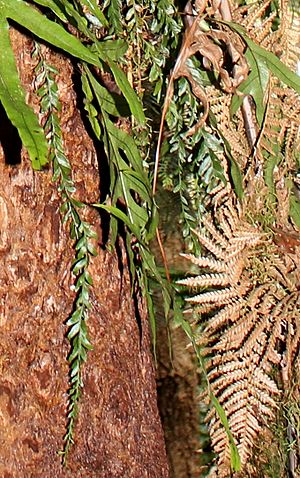Long fork fern facts for kids
Quick facts for kids Long fork fern |
|
|---|---|
 |
|
| T. obliqua growing on a Dicksonia antarctica | |
| Scientific classification | |
| Genus: |
Tmesipteris
|
| Species: |
obliqua
|
The Long fork fern (Tmesipteris obliqua) is a unique plant. It's also called the Common fork fern. This plant is a type of epiphyte. This means it grows on other plants, like tree ferns, but doesn't harm them. It has long, narrow stems with leaves. The Long fork fern is found only in eastern Australia. It belongs to a group of plants called "hanging fork-ferns."
Contents
About the Long Fork Fern
The Long fork fern is a fern ally. This means it's related to ferns but isn't a true fern. It often hangs down, giving it a "weeping" look. You can find it growing on the trunks of tree ferns. A common host is the soft tree fern (Dicksonia antarctica). Sometimes, it also grows on rocky surfaces.
What Does It Look Like?
The stems of the Long fork fern are usually unbranched. They can grow quite long, from about 20 to 65 centimeters (8 to 25 inches).
Instead of true roots, this plant has a thick, fleshy part called a rhizome. This rhizome helps the plant attach itself and absorb nutrients. It's quite delicate and can break easily if disturbed. The stems are smooth at the bottom. They have a single groove on their upper surface.
Its Leaves
The leaves of the Long fork fern are oblong in shape. They can be around 20 to 30 millimeters (0.8 to 1.2 inches) long. They are about 4 to 8 millimeters (0.16 to 0.3 inches) wide. The leaves are not crowded together. They are spaced out, with about three leaves per centimeter. The base and tip of each leaf are a bit uneven. Younger leaves near the top of the stem are smaller.
How It Reproduces
Long fork ferns do not produce flowers or seeds. Instead, they reproduce using spores. These spores are held in special capsules. These capsules are called sporangia. They are found at the base of small, forked leaf-like structures. These structures are called bracts. The bracts are narrower and shorter than the regular leaves.
Where Long Fork Ferns Live
The Long fork fern is an epiphyte. It is often found growing on the trunks of tree-ferns. It especially likes the soft tree-fern (Dicksonia antarctica). You might also spot it on shady, moist rock faces.
This plant is common in eastern Australia. It grows from sea level up to about 600 meters (2,000 feet) high. You can find it in places like fern gullies, rainforests, and wet sclerophyll forests. It loves moist, shady, and humid environments. It can grow on mossy logs, rocks, or even among exposed roots.
Growing Long Fork Ferns
It is very hard to grow the Long fork fern in a garden. This is because it has very specific needs. Since it's an epiphyte, it needs lots of rain and shade. It also needs a humid environment. These conditions are hard to create outside of its natural home. The plant is also very delicate.


